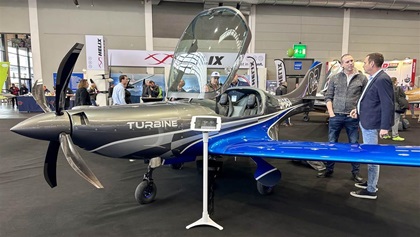Aero’s crystal ball
Europe’s biggest GA convention maintains its focus on traditional designs and future trends

 If you want a glimpse of how general aviation could look in a few years, then Aero is the place to go. Europe’s biggest convention focused solely on GA, held in Friedrichshafen, Germany, once again maintained its focus on both traditional designs and future trends.
If you want a glimpse of how general aviation could look in a few years, then Aero is the place to go. Europe’s biggest convention focused solely on GA, held in Friedrichshafen, Germany, once again maintained its focus on both traditional designs and future trends.
Its 290,000 attendees and 670 exhibitors represented a closure on the more populous pre-COVID days’ attendance records, and this year’s show attracted more international visitors, notably including a significant presence from Sweden. Of course, exhibitors from the United States continued their large presence: to name a few, Cirrus Aircraft, Textron eAviation, Piper Aircraft, Garmin, Boeing subsidiaries Jeppesen and ForeFlight, as well as Gulfstream Aerospace, which displayed the new G500 (a first for Gulfstream, and the first large-cabin, global-range bizjet to visit Aero). But as you might expect, this convention has a distinctly European look and feel.
This manifests in several ways. Much more so than in the United States, European culture, industry, and daily life are marked by a pervasive concern about carbon and emissions reductions, sustainable fuel, and the technology that advances those goals. This concern is reflected in Aero’s dedication to tracking progress in alternative propulsion schemes. This is the tenth year that Aero dedicated exhibit halls to what it calls “e-flight expos.” There you’ll see current designs making use of battery-electric and hydrogen-powered airplanes—some of which are certified under certain European rules. This year’s e-flight expo had some 126 exhibitors.
Then there are the exhibits that represent prototype designs and pure research efforts. Technical universities in Germany and other European Union states sponsor programs that allow students to learn the science behind electric and hydrogen propulsion. One large exhibit area showed off the work of students from six different German educational institutions.
To be frank, electric vertical takeoff and landing aircraft (eVTOL) and the more ambitious hydrogen designs—plentiful at previous Aeros—seemed less well-represented this year. Instead, there were more conventional, winged aircraft using electric and hydrogen power.
Markus Fischer, a divisional board member for aeronautics at the German Aerospace Center (DLR), speaking at an Aero preshow media day panel discussion, seemed to be addressing the challenges that the eVTOL movement faces when he reminded the audience of a well-worn saying in the aircraft manufacturing business: “You must never over-promise, then under-deliver on a design. This is the biggest danger in the development of all aircraft, and it’s especially true at times like these. It will kill the future of the new design, investors will leave, and the future of the industry will be at risk,” Fischer said, adding that he was “not an eVTOL person.”
Cate Brancart, manager of European operations and safety for the General Aviation Manufacturers Association, emphasized the need for newer, more sophisticated training aircraft in the next two years, citing pilot shortages. Fischer’s DLR sponsors summer schools aimed at cultivating future engineers—another area where shortages are growing.
Claus Cordes, president of the German Aero Club, which is involved in overseeing the standards for the ultralight class of airplanes in that nation, also talked about the pilot shortage. “Air sports can be a significant future talent source for both pilots and the aviation industry in general,” he said.




